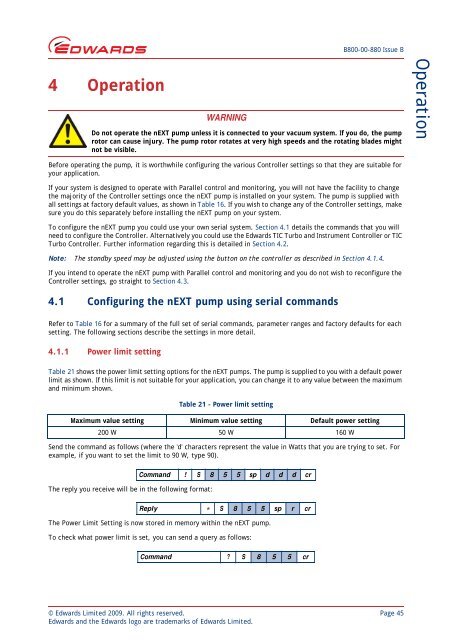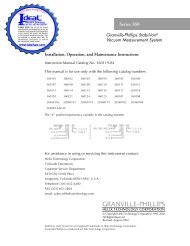Edwards, nEXT Turbomolecular Pumps, nEXT240, nEXT300 and ...
Edwards, nEXT Turbomolecular Pumps, nEXT240, nEXT300 and ...
Edwards, nEXT Turbomolecular Pumps, nEXT240, nEXT300 and ...
Create successful ePaper yourself
Turn your PDF publications into a flip-book with our unique Google optimized e-Paper software.
B800-00-880 Issue B<br />
4 Operation<br />
WARNING<br />
Do not operate the <strong>nEXT</strong> pump unless it is connected to your vacuum system. If you do, the pump<br />
rotor can cause injury. The pump rotor rotates at very high speeds <strong>and</strong> the rotating blades might<br />
not be visible.<br />
Operation<br />
Before operating the pump, it is worthwhile configuring the various Controller settings so that they are suitable for<br />
your application.<br />
If your system is designed to operate with Parallel control <strong>and</strong> monitoring, you will not have the facility to change<br />
the majority of the Controller settings once the <strong>nEXT</strong> pump is installed on your system. The pump is supplied with<br />
all settings at factory default values, as shown in Table 16. If you wish to change any of the Controller settings, make<br />
sure you do this separately before installing the <strong>nEXT</strong> pump on your system.<br />
To configure the <strong>nEXT</strong> pump you could use your own serial system. Section 4.1 details the comm<strong>and</strong>s that you will<br />
need to configure the Controller. Alternatively you could use the <strong>Edwards</strong> TIC Turbo <strong>and</strong> Instrument Controller or TIC<br />
Turbo Controller. Further information regarding this is detailed in Section 4.2.<br />
Note: The st<strong>and</strong>by speed may be adjusted using the button on the controller as described in Section 4.1.4.<br />
If you intend to operate the <strong>nEXT</strong> pump with Parallel control <strong>and</strong> monitoring <strong>and</strong> you do not wish to reconfigure the<br />
Controller settings, go straight to Section 4.3.<br />
4.1 Configuring the <strong>nEXT</strong> pump using serial comm<strong>and</strong>s<br />
Refer to Table 16 for a summary of the full set of serial comm<strong>and</strong>s, parameter ranges <strong>and</strong> factory defaults for each<br />
setting. The following sections describe the settings in more detail.<br />
4.1.1 Power limit setting<br />
Table 21 shows the power limit setting options for the <strong>nEXT</strong> pumps. The pump is supplied to you with a default power<br />
limit as shown. If this limit is not suitable for your application, you can change it to any value between the maximum<br />
<strong>and</strong> minimum shown.<br />
Table 21 - Power limit setting<br />
Maximum value setting Minimum value setting Default power setting<br />
200 W 50 W 160 W<br />
Send the comm<strong>and</strong> as follows (where the 'd' characters represent the value in Watts that you are trying to set. For<br />
example, if you want to set the limit to 90 W, type 90).<br />
The reply you receive will be in the following format:<br />
Comm<strong>and</strong> ! S 8 5 5 sp d d d cr<br />
Reply S 8 5 5 sp r cr<br />
The Power Limit Setting is now stored in memory within the <strong>nEXT</strong> pump.<br />
To check what power limit is set, you can send a query as follows:<br />
Comm<strong>and</strong> ? S 8 5 5 cr<br />
© <strong>Edwards</strong> Limited 2009. All rights reserved. Page 45<br />
<strong>Edwards</strong> <strong>and</strong> the <strong>Edwards</strong> logo are trademarks of <strong>Edwards</strong> Limited.
















